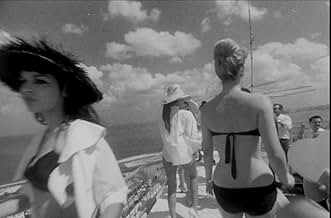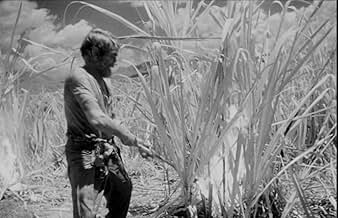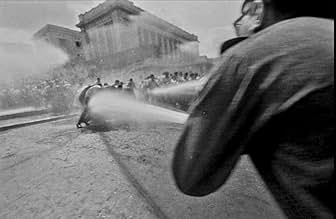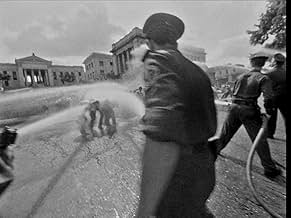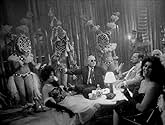CALIFICACIÓN DE IMDb
8.2/10
11 k
TU CALIFICACIÓN
Cuatro historias sobre la vida del pueblo cubano ambientadas durante la era prerrevolucionaria.Cuatro historias sobre la vida del pueblo cubano ambientadas durante la era prerrevolucionaria.Cuatro historias sobre la vida del pueblo cubano ambientadas durante la era prerrevolucionaria.
- Premios
- 2 premios ganados y 1 nominación en total
Mario González Broche
- Pablo
- (as Mario González)
- Dirección
- Guionistas
- Todo el elenco y el equipo
- Producción, taquilla y más en IMDbPro
Argumento
¿Sabías que…?
- TriviaThe now famous long take that begins at the top of the hotel, then winds around and down into the swimming pool, originally come out of the water and continued. The camera was hand held, passed from crew member to crew member, to make its way down the side of the hotel into the pool. The camera lens had been equipped with a high speed, spinning glass disk taken from a submarine periscope. The spinning disk was installed to fling water drops off of the lens when the camera emerged from the swimming pool at the end of the shot. Much to the disappointment of the camera crew, director Mikhail Kalatozov cut the end of the take, ending it underwater.
- ErroresWhen Enrique gets to the top of the high-rise building he gains access to the roof by stepping through a window with a broken pane of glass. When he returns, the pane in same window is unbroken.
- ConexionesFeatured in Soy Cuba, el mamut siberiano (2004)
- Bandas sonorasLoco amor
(Spanish-speaking adaptation of the 1958 song "Crazy Love")
Music and lyrics by Paul Anka
Performed by El Duo Los Diablos (as Los Diablos Demonicos)
Added accompaniment music recorded later at the Prado 210 studio
With Chucho Valdés (piano), Guillermo Barreto (drums) and Orlando "Cachaito" Lopez (bass).
Opinión destacada
"Don't avert your eyes. Look! I am Cuba. For you, I am the casino, the bar, hotels and brothels. But the hands of these children and old people are also me" -- Yevgeni Yevtushenko
I Am Cuba is described by film critic Elliot Wilhelm as "a unique, insane, exhilarating spectacle". Filmed in Spanish, dubbed in Russian, and subtitled in English, this unique collaboration between Russian director Mikhail Kalatozov (The Cranes are Flying), the poet Yevgeni Yevtushenko, and writer Enrique Pineda Barnet dramatizes the conditions that led to the 1959 Cuban revolution. Originally made in 1964 (and unpopular both in Russia and Cuba), it was released in 1995 through the combined efforts of Martin Scorsese and Francis Ford Coppola.
I Am Cuba is set in the late 1950s when a ragtag bunch of students, workers, and peasants organized to overthrow the corrupt regime of dictator Fulgencio Batista. The film is divided into four sequences. The first depicts the American-run gambling casinos and prostitution in Havana. The next shows a farmer burning his sugar cane when he learns he is going to lose his land to United Fruit. Another describes the suppression of students and dissenters at Havana University, and the final sequence shows how government bombing of mountain fields induced farmers to join with the rebels in the Sierra Maestre mountains. The final scene is a triumphal march into Havana to proclaim the revolution.
Marvelously photographed in black and white by Sergei Urusevsky and using acrobatic camerawork by Alexandr Kalzaty, some of the shots and distorted camera angles are so staggering as to be virtually unbelievable. In one sequence, the camera lifts off from a hotel rooftop, takes in the Havana skyline, descends several floors, winds its way through the poolside party-goers, and then takes you for a swim in the pool in one continuous shot. Reminiscent of Sergei Eisenstein, the caricatures are broad but are presented with such exuberance that it hardly seems to matter. Audacious and imaginative, I Am Cuba is a revelation, not only for its style but also for its inspiration. Filmed with true visionary poetry, I Am Cuba transcends the genre of advocacy filmmaking to reach a pinnacle of cinematic art.
I Am Cuba is described by film critic Elliot Wilhelm as "a unique, insane, exhilarating spectacle". Filmed in Spanish, dubbed in Russian, and subtitled in English, this unique collaboration between Russian director Mikhail Kalatozov (The Cranes are Flying), the poet Yevgeni Yevtushenko, and writer Enrique Pineda Barnet dramatizes the conditions that led to the 1959 Cuban revolution. Originally made in 1964 (and unpopular both in Russia and Cuba), it was released in 1995 through the combined efforts of Martin Scorsese and Francis Ford Coppola.
I Am Cuba is set in the late 1950s when a ragtag bunch of students, workers, and peasants organized to overthrow the corrupt regime of dictator Fulgencio Batista. The film is divided into four sequences. The first depicts the American-run gambling casinos and prostitution in Havana. The next shows a farmer burning his sugar cane when he learns he is going to lose his land to United Fruit. Another describes the suppression of students and dissenters at Havana University, and the final sequence shows how government bombing of mountain fields induced farmers to join with the rebels in the Sierra Maestre mountains. The final scene is a triumphal march into Havana to proclaim the revolution.
Marvelously photographed in black and white by Sergei Urusevsky and using acrobatic camerawork by Alexandr Kalzaty, some of the shots and distorted camera angles are so staggering as to be virtually unbelievable. In one sequence, the camera lifts off from a hotel rooftop, takes in the Havana skyline, descends several floors, winds its way through the poolside party-goers, and then takes you for a swim in the pool in one continuous shot. Reminiscent of Sergei Eisenstein, the caricatures are broad but are presented with such exuberance that it hardly seems to matter. Audacious and imaginative, I Am Cuba is a revelation, not only for its style but also for its inspiration. Filmed with true visionary poetry, I Am Cuba transcends the genre of advocacy filmmaking to reach a pinnacle of cinematic art.
- howard.schumann
- 17 nov 2002
- Enlace permanente
Selecciones populares
Inicia sesión para calificar y agrega a la lista de videos para obtener recomendaciones personalizadas
- How long is I Am Cuba?Con tecnología de Alexa
Detalles
- Fecha de lanzamiento
- Países de origen
- Sitio oficial
- Idiomas
- También se conoce como
- I Am Cuba
- Locaciones de filmación
- Calle M & 23 Ave, La Habana, Cuba(rooftop scene: Enrique as a sniper)
- Productoras
- Ver más créditos de la compañía en IMDbPro
Taquilla
- Total en EE. UU. y Canadá
- USD 168,100
- Total a nivel mundial
- USD 274,098
- Tiempo de ejecución2 horas 21 minutos
- Color
- Mezcla de sonido
- Relación de aspecto
- 1.37 : 1
Contribuir a esta página
Sugiere una edición o agrega el contenido que falta

Principales brechas de datos
By what name was Soy Cuba (1964) officially released in India in English?
Responda




